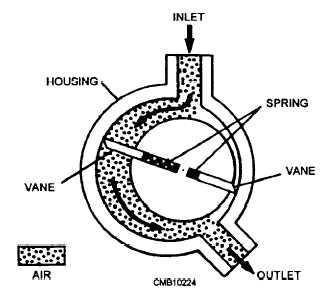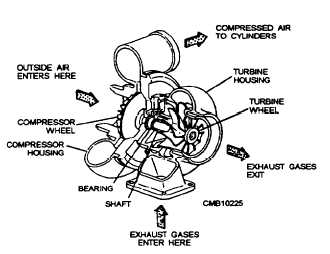
Figure 5-41. - Vane-type supercharger.
The supercharger raises the air pressure in the engine intake manifold. Then, when the intake valves open, more air-fuel mixture (gasoline engine) or air (diesel engine) can flow into the cylinders. An intercooler is used between the supercharger outlet and the engine to cool the air and to increase power (cool charge of air carries more oxygen needed for combustion).
A supercharger will instantly produce increased pressure at low engine speed because it is mechanically linked to the engine crankshaft. This low-speed power and instant throttle response is desirable for passing and entering interstate highways.
TURBOCHARGERS
A turbocharger is an exhaust-driven supercharger (fan or blower) that forces air into the engine under pressure. Turbochargers are frequently used on small gasoline and diesel engines to increase power output. By harnessing engine exhaust energy, a turbocharger can also improve engine efficiency (fuel economy and emissions levels).
The turbocharger (fig. 5-42) consists of three basic parts - a turbine wheel; an impeller or compressor; and housings that support the parts and direct the flow of exhaust gases and intake air. Basic operation of a turbocharger is as follows:
When the engine is running, hot gases blow out the open exhaust valves and into the exhaust manifold. The exhaust manifold and connecting tubing route these gases into the turbine housing.

Figure 5-42. - Turbocharger (cutaway view).
As the gases pass through the turbine housing, they strike the fins or blades on the turbine wheel. When engine load is high enough, there is enough exhaust gas flow to spin the turbine wheel rapidly.
Since the turbine wheel is connected to the impeller by the turbo shaft, the impeller rotates with the turbine. Impeller rotation pulls air into the compressor housing. Centrifugal force throws the spinning air outward. This causes air to flow out of the turbocharger and into the engine cylinder under pressure.
A turbocharger is located on one side of the engine. An exhaust pipe connects the exhaust manifold to the turbine housing. The exhaust system header pipe connects to the outlet of the turbine housing.
Theoretically, the turbocharger should be located as close to the engine manifold as possible. Then a maximum amount of exhaust heat will enter the turbine housing. When the hot gases move past the spinning turbine wheel, they are still expanding and help rotate the turbine.
Turbocharger lubrication is required to protect the turbo shaft and bearings from damage. A turbocharger can operate at speeds up to 100,000 rpm. For this reason, the engine lubrication system forces oil into the turbo shaft bearings. Oil passages are provided in the turbo housing and bearings and an oil supply line runs from the engine to the turbocharger. With the engine running, oil enters the turbocharger under pressure. A
Continue Reading